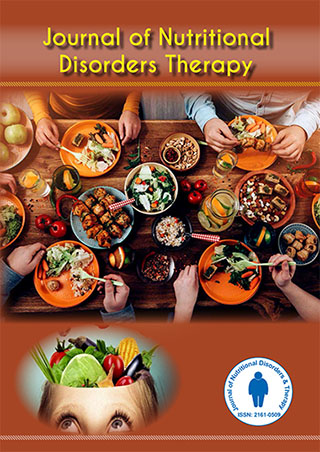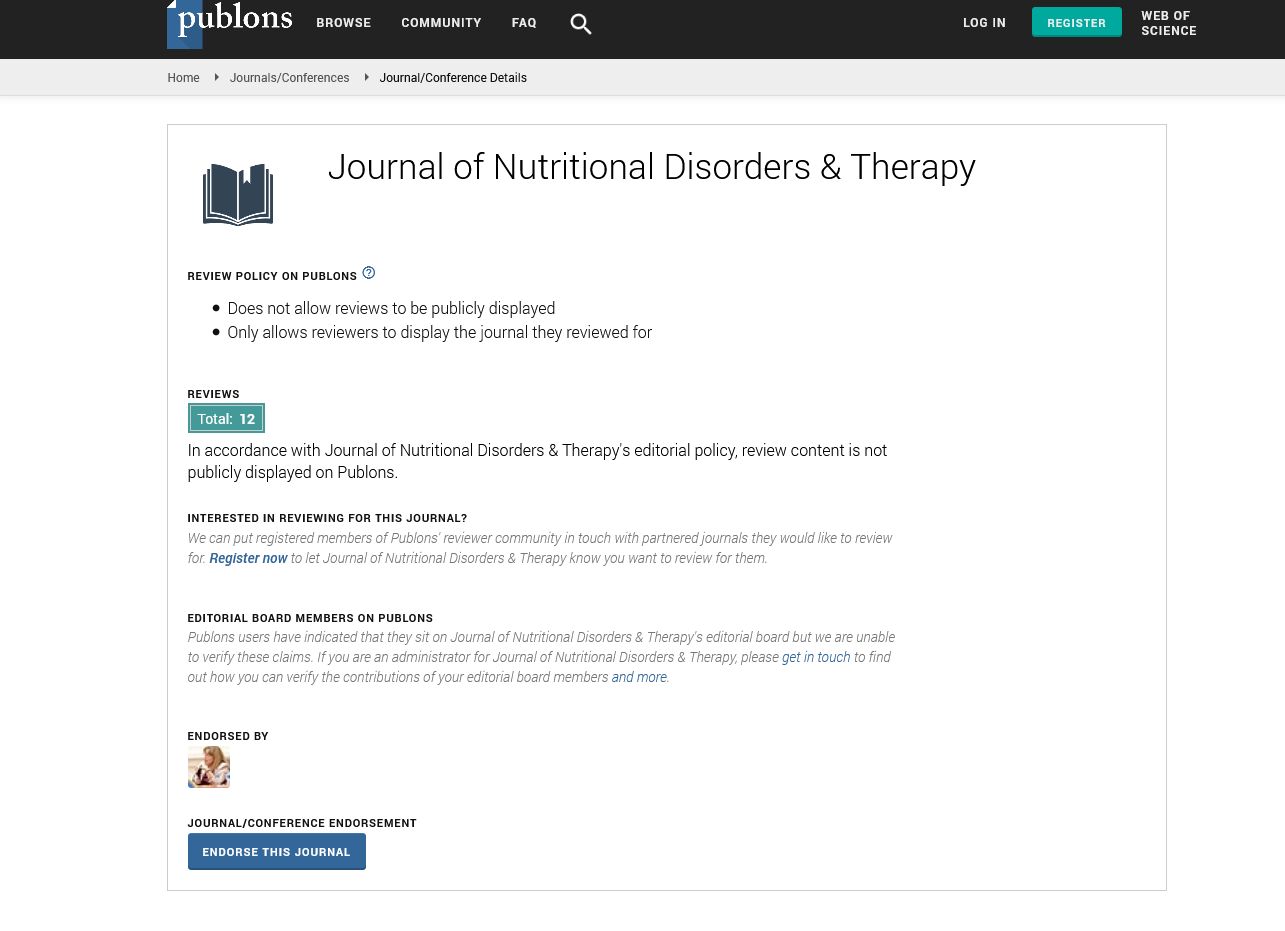Indexed In
- Open J Gate
- Genamics JournalSeek
- Academic Keys
- JournalTOCs
- Ulrich's Periodicals Directory
- RefSeek
- Hamdard University
- EBSCO A-Z
- OCLC- WorldCat
- Publons
- Geneva Foundation for Medical Education and Research
- Euro Pub
Useful Links
Share This Page
Journal Flyer

Open Access Journals
- Agri and Aquaculture
- Biochemistry
- Bioinformatics & Systems Biology
- Business & Management
- Chemistry
- Clinical Sciences
- Engineering
- Food & Nutrition
- General Science
- Genetics & Molecular Biology
- Immunology & Microbiology
- Medical Sciences
- Neuroscience & Psychology
- Nursing & Health Care
- Pharmaceutical Sciences
Perspective - (2024) Volume 14, Issue 4
Nutritional Rickets: A Comprehensive Review of Vitamin D and Other Essential Nutrients
Suzanne Bradley*Received: 22-Nov-2024, Manuscript No. JNDT-24-27633; Editor assigned: 25-Nov-2024, Pre QC No. JNDT-24-27633(PQ); Reviewed: 09-Dec-2024, QC No. JNDT-24-27633; Revised: 16-Dec-2024, Manuscript No. JNDT-24-27633(R); Published: 23-Dec-2024, DOI: 10.35248/2161-0509.24.14.312
Description
Nutritional rickets, a disorder primarily linked to a deficiency in vitamin D, has long been associated with childhood growth disturbances, bone deformities and developmental delays. Traditionally, the condition has been thought to arise solely from a lack of vitamin D, an essential nutrient for calcium and phosphorus metabolism. However, recent research has revealed that nutritional rickets is more complex than previously thought and other factors beyond vitamin D deficiency are contributing to its pathophysiology. These include disturbances in calcium and phosphorus homeostasis, genetic predispositions and the role of other nutrients in bone health. To truly address the growing concern of nutritional rickets, it is essential to broaden the scope of its investigation beyond vitamin D alone.
Vitamin D is important for bone health because it helps the body absorb calcium and phosphorus from the digestive tract. It also plays a vital role in maintaining optimal levels of calcium and phosphorus in the bloodstream, which are essential for bone mineralization. Without sufficient vitamin D, the body cannot properly absorb calcium from the diet, leading to a deficiency in mineralized bone matrix and the development of rickets. This condition is marked by softened bones that can lead to skeletal deformities such as bowed legs, a curved spine and in severe cases, fractures.
The primary source of vitamin D for the body is sunlight, which triggers the production of the vitamin in the skin. However, factors such as limited sun exposure, living in regions with long winters, dark skin pigmentation and the use of sunscreen can all reduce the skin's ability to produce adequate amounts of vitamin D. This is particularly problematic in developing countries or regions where malnutrition and insufficient access to fortified foods are common.
While vitamin D deficiency is the primary cause of nutritional rickets, it is important to recognize the essential roles of calcium and phosphorus in the condition. These two minerals work in tandem to ensure proper bone structure and function. Calcium is a key structural component of bones, providing rigidity and strength, while phosphorus contributes to the formation of hydroxyapatite, a mineral compound that gives bones their density and hardness.
Inadequate dietary intake of calcium or phosphorus can exacerbate the effects of vitamin D deficiency, leading to more severe cases of rickets. Children with limited access to dairy products, certain vegetables and fortified foods are at a higher risk of deficiencies in both minerals. Additionally, disruptions in calcium and phosphorus metabolism due to genetic conditions or kidney disease can increase susceptibility to rickets, even if vitamin D levels are sufficient.
While vitamin D, calcium and phosphorus are central to the development of nutritional rickets, other nutrients also play significant roles in maintaining bone health. These include magnesium, vitamin K, zinc and vitamin A, all of which contribute to bone mineralization and overall skeletal integrity.
Magnesium is essential for the activity of osteoblasts, the cells responsible for bone formation. It also helps regulate calcium and phosphorus levels in the body, ensuring proper mineralization of the bone matrix. Deficiencies in magnesium can impair bone growth and mineralization, leading to weakened bones and increased risk of rickets.
Vitamin K is critical for the activation of osteocalcin, a protein that helps bind calcium to the bone matrix, promoting strong and healthy bones. Inadequate vitamin K levels, often seen in children with poor diets or those with certain gastrointestinal disorders, can hinder bone mineralization, increasing the risk of rickets-like symptoms.
Zinc also plays a role in bone growth and the synthesis of collagen, a protein that provides structure to bones and cartilage. A deficiency in zinc can delay bone development and contribute to skeletal deformities.
Vitamin A, although best known for its role in vision and immune function, is also involved in bone remodeling. It supports the activity of osteoclasts, the cells responsible for breaking down bone tissue, which is a necessary process for bone turnover. An imbalance in vitamin A levels, either through deficiency or excess, can impair bone health and contribute to rickets.
Conclusion
Nutritional rickets is a complex condition that extends beyond vitamin D deficiency alone. While vitamin D remains a central factor in bone health, the roles of calcium, phosphorus and other nutrients cannot be overlooked. Furthermore, genetic factors and the interplay between various nutrients must be considered when diagnosing and treating rickets. As our understanding of the multifactorial nature of the disease grows, a more holistic approach to prevention and treatment will be required to effectively combat this preventable condition. By addressing not just vitamin D, but the broader nutritional landscape, we can improve bone health and reduce the burden of rickets globally.
Citation: Bradley S (2024). Nutritional Rickets: A Comprehensive Review of Vitamin D and Other Essential Nutrients. J Nutr Disord Ther. 14:312.
Copyright: © 2024 Bradley S. This is an open-access article distributed under the terms of the Creative Commons Attribution License, which permits unrestricted use, distribution, and reproduction in any medium, provided the original author and source are credited.

